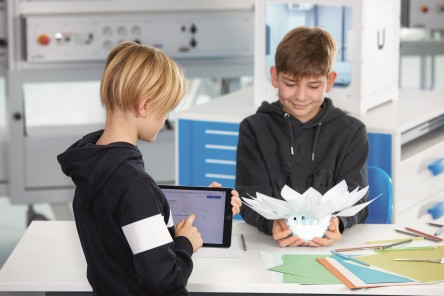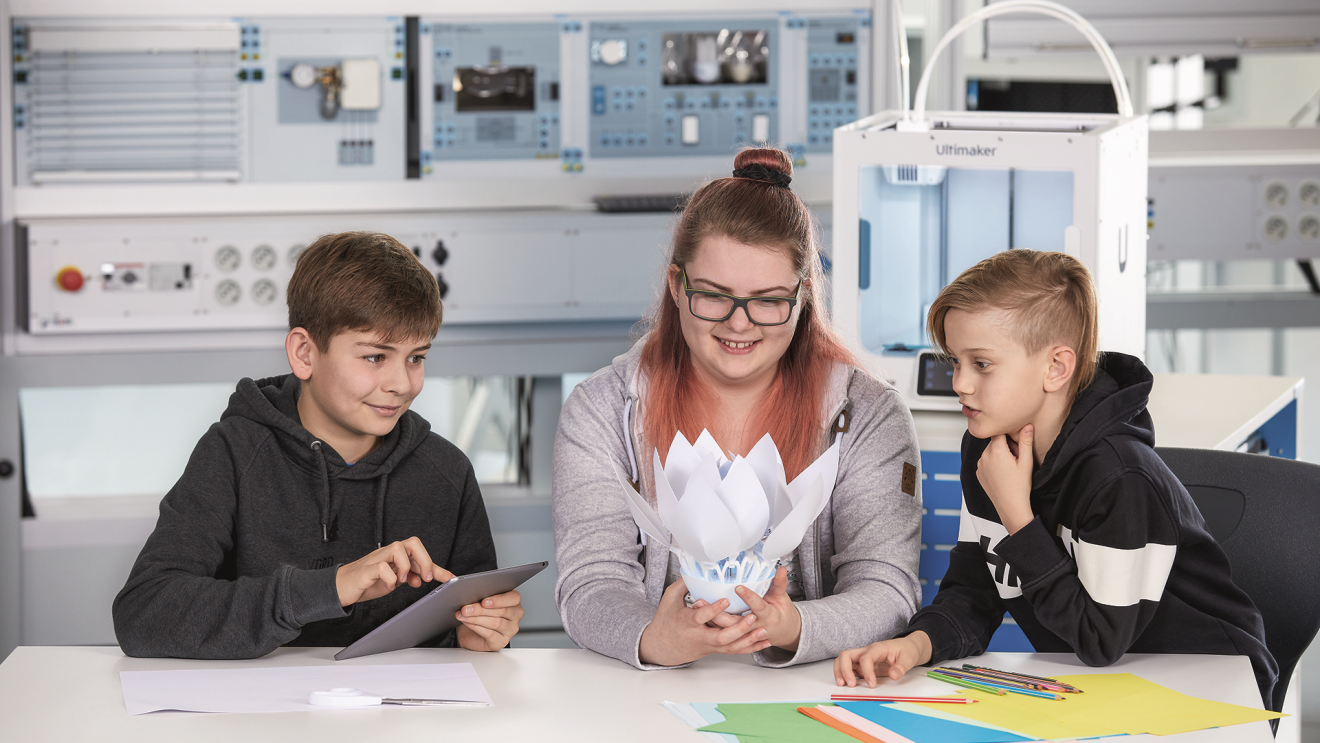
These mechanisms of action are simulated with sensors and actuators and can be learned in a playful way by students in class.The attractive design that mimics the natural model and the transfer of principles from the plant world to technology add new fascinating topics to Festo’s STEM curriculum.
The basic functions of the robot flower can be used without programming. Furthermore, the microcontroller can be programmed with the graphic coding interface “Open Roberta”.
In the "Bionic Flower" course, students discover how flowers behave in their environment and how they optimally adapt. Based on this, there are simple hands-on experiments with paper on the topic of folding structures. On the subject of the importance of light, special attention is paid to the technical realization in the form of LEDs. But also the technical realization of sensor and actuator technology in relation to the natural mechanisms of action of the water lily and the mimosa are explained.
You are interested in the Bionic Flower? Get in touch!
Assembly instructions
The Bionic Flower is a robot flower inspired by the world of plants. In the video we will show you a detailed step-by-step assembly of our Bionic Flower Experimental Set.
Tutorial
Are you excited about the fascinating plant world? Did you ever wonder how plants open and close their petals due to external influences such as touch or light? In the video, Dr. Reinhard Pittschellis from our Bionics4Education team is talking about bionics and the function of our Bionic Flower.
More experiments
Design your own petals
- If you want to make your own folded petals from regular paper, we have created a template for you. Of course, you can then also design your petals individually. Download our "flower petals" template (pdf)
Easy Paper Experiment for folding structure
- Some plants use special folding structures to adapt even better to their living conditions. If you want to find out for yourself which stability can be realized by corresponding folding structures, try this experiment. Download our "sandwich" template (pdf)
- You can find instructions in our Festo LX course "Bionic Flower.
Biological Background
Natural Role Models
Festo Didactic took the mechanisms of action of water lilies and mimosa as a model for the development of the Bionic Flower. These plants have one thing in common: the opening and closing of their leaves due to external stimuli. The effects serve for reproduction and protection against natural enemies.
Natural Role Model – Water Lilies

The water lily is an aquatic plant that is anchored in bodies of water. The single standing flowers have a spiraled-like structure triggered by light and thus allow the opening and closing of their petals. Day-flowering water lilies open their petals in the morning and thus attract insects to pollinate the flowers. But how exactly does the movement of the petals work?
The principle is based on differences in growth between the outside and inside of the petals. So the inside of the petals grows under bright light and the flower opens. If there is not enough light, the outer side grows and the flower closes.
Natural Role Model – Mimosa Plant

The leaves of the mimosa plant fold one after the other when subjected to mechanical stimuli such as touch or vibration nearby, and the stem sinks. This serves to protect against possible predators.
The successive folding of the pinnules takes place like a chain reaction (domino effect). An ingenious mechanism within the water-filled cell structures in the pinnules ensures that water is released from the cell when an external stimulus is applied. This means that no more water presses from the inside against the cell walls, the cell relaxes and the pinnules contract.

21st Century Skills
The bionics learning construction kit can be developed in teamwork. A team can consist of two or more people. This gives an idea of how interdisciplinary development teams work together in projects, for example in industry, in order to jointly develop a product. These fosters e.g. four key competencies for the digital age like communication, collaboration, critical thinking and creativity.
As soon as the team is formed, common goals have to be defined. Only then can everyone work efficiently towards the same goal. The following questions should be asked in the team first.
Ask these questions in your team:
- What kind of flower do we want to build?
- Should this robot flower be based on a certain biological model?
- What should the robot flower be able to do?
- What do we want to learn from the real thing?
In order to put together certain task packages in a team, it is helpful to proceed in a structured manner and with a division of labor. Among other things, project management helps here. Project plans provide a simple visual overview of a project from start to finish and lead to a higher work efficiency of the team members.
Further information on how to create teams in a playful way visit "Teamwork”
For tips on how to implement the project, you will get a list of tasks that are necessary to build the bionic inspired flower. You can develop a project plan that identifies tasks assigned to each team member that need to be completed within a certain time frame.
STEM Connections

Sience, Technology, Engineering, Math
Science
- Know folding structures in nature and technology
- Explain the term bionics
Technology
- Use touch and light sensor
- Connect stepper motor and sensors
Engineering
- Program with Open Roberta (Scratch) or C++
- Build the robot flower
Math
- Folding structures: bending beam, area moment of inertia
All downloads and links at a glance
Bionic Flower
General downloads
- Brochure Bionic Flower (pdf)
- Assembly Instruction Bionic Flower (pdf)
- Ideas for teaching classes (pdf)
- Project Plan Bionic Flower (pdf)
- Learning path (pdf)
Additional downloads
LX Course
Festo LX Course "Bionic Flower" (Link)
Software
Open Roberta for Bionic Flower
- Open Roberta Connector (zip)
- Introduction: How to use Open Roberta (pdf)
- Easy Start with Coding – Open Roberta coding activities Level (I-III) (pdf)
- Open Roberta Bionic Flower Courseware (pdf)
Arduino Software
- Arduino Portable version to program Bionic Flower (zip)
- Arduino Portable version Introduction (pdf)
- GitHub
FAQs & Legal information
